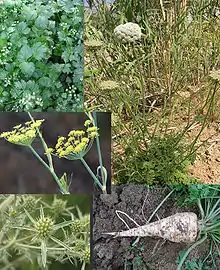Maydanozgiller
Maydanozgiller (Apiaceae ya da Umbelliferae, her ikisi de ICBN tarafından kabul edilmektedir), çoğu 2 yıllık tek veya çok yıllık, otsu, nadiren çalımsı olan aromatik kokulu bitkileri kapsayan bir çiçekli bitkiler familyası.
| Maydanozgiller | |||||||||||||
|---|---|---|---|---|---|---|---|---|---|---|---|---|---|
 | |||||||||||||
| Bilimsel sınıflandırma | |||||||||||||
| |||||||||||||
| Tip cins | |||||||||||||
| Apium | |||||||||||||
| Altfamilyalar | |||||||||||||
| |||||||||||||
| Sinonimler | |||||||||||||
| Umbelliferae | |||||||||||||
Morfolojik özellikleri
Büyük bir familya olup, yaklaşık 300 civarında cins ve 3,000'den fazla tür içerir. Bitkilerin gövdeleri, özellikle kuruyunca içleri boşalır. Yapraklar almaşık dizilişlidir. Çoğu cinste tabanda toplanmışlardır. Çiçek kurulu genellikle basit veya bileşik şemsiye durumundadır. Çiçeklerinin şemsiye gibi görünmesinden dolayı eskiden "şemsiye taşıyanlar" anlamına Umbelliferae adı kullanılıyordu.
Familya üyeleri genellikle kuzey yarım kürede yaygındır. Uçucu yağ ve reçine elde edilen maydanozgiller, Türkiye'de zengin bir tür sayısına sahiptir.
Cinsleri
|
|
|
Kaynakça
Konuyla ilgili yayınlar
- Constance, L. (1971). "History of the classification of Umbelliferae (Apiaceae)." in Heywood, V. H. [ed.], The biology and chemistry of the Umbelliferae, 1–11. Academic Press, London.
- Cronquist, A. (1968). The Evolution and Classification of Flowering Plants. Boston: Houghton Mifflin.
- "Don't touch these plants! Six lookalikes you want to avoid". Medium. U.S. Fish & Wildlife Service. 19 Temmuz 2017. 19 Mart 2018 tarihinde kaynağından arşivlendi. Erişim tarihi: 11 Ağustos 2018.
- French, D. H. (1971). "Ethnobotany of the Umbelliferae." in Heywood, V. H. [ed.], The biology and chemistry of the Umbelliferae, 385–412. Academic Press, London.
- Hegnauer, R. (1971) "Chemical Patterns and Relationships of Umbelliferae." in Heywood, V. H. [ed.], The biology and chemistry of the Umbelliferae, 267–277. Academic Press, London.
- Heywood, V. H. (1971). "Systematic survey of Old World Umbelliferae." in Heywood, V. H. [ed.], The biology and chemistry of the Umbelliferae, 31–41. Academic Press, London.
- Judd, W. S. et al. (1999). Plant Systematics: A Phylogenetic Approach. Sunderland, MA: Sinauer Associates, Inc.
- Plunkett, G. M.; Downie, S. R. (1999). "Major lineages within Apiaceae subfamily Apioideae: a comparison of chloroplast restriction site and DNA sequence data". American Journal of Botany. 86 (7): 1014-1026. doi:10.2307/2656619. JSTOR 2656619. PMID 10406725. Geçersiz
|doi-access=free(yardım) - Plunkett, G. M.; Soltis, D. E.; Soltis, P. S. (1996). "Higher Level Relationships of Apiales (Apiaceae and Araliaceae) Based on Phylogenetic Analysis of rbcL Sequences". Botanical Society of America. 83 (4): 499-515. doi:10.2307/2446219. JSTOR 2446219.
- Plunkett, G. M.; Soltis, D. E.; Soltis, P. S. (1996). "Evolutionary Patterns in Apiaceae: Inferences Based on matK Sequence Data". American Society of Plant Taxonomists. 21 (4): 477-495. doi:10.2307/2419610. JSTOR 2419610.
- Nieto Feliner, Gonzalo; Jury, Stephen Leonard & Herrero Nieto, Alberto (eds.) Flora iberica. Plantas vasculares de la Península Ibérica e Islas Baleares. Vol. X. "Araliaceae-Umbelliferae" (2003) Madrid: Real Jardín Botánico, CSIC (in Spanish).
- Scavo, Tom (11 Ağustos 2011). "Wild Parsnip and Friends in Vermont". Green Mountain Club. 11 Ağustos 2018 tarihinde kaynağından arşivlendi. Erişim tarihi: 11 Ağustos 2018.
Dış bağlantılar
| Wikimedia Commons'ta Apiaceae ile ilgili ortam dosyaları bulunmaktadır. |
- Umbelliferae at The Families of Flowering Plants (DELTA)
- Apiaceae at Discover Life
- Umbellifer Resource Centre at the Royal Botanic Garden Edinburgh
- Umbellifer Information Server at Moscow State University
